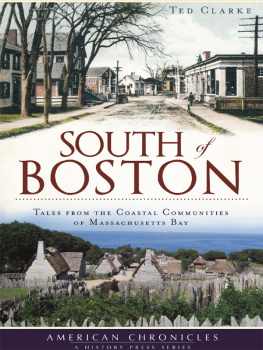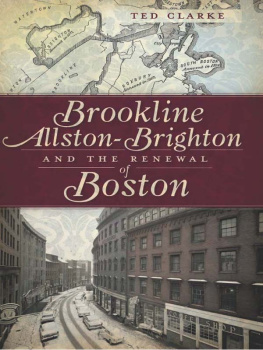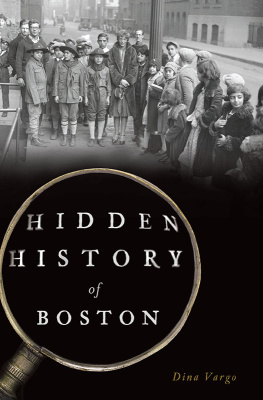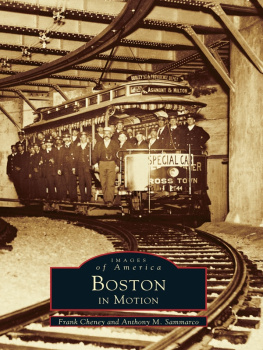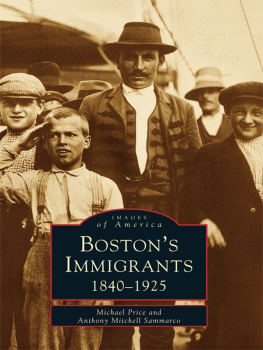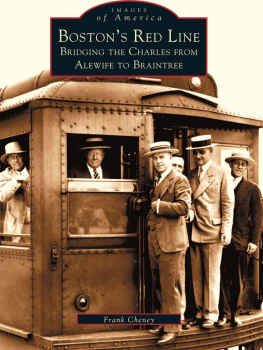BEACON HILL,
BACK BAY
AND THE BUILDING OF
B OSTONS
G OLDEN A GE
BEACON HILL,
BACK BAY
AND THE BUILDING OF
BOSTONS
GOLDEN AGE
T ED C LARKE

Published by The History Press
Charleston, SC 29403
www.historypress.net
Copyright 2010 by Ted Clarke
All rights reserved
Front cover: View of the city of Boston from Dorchester Heights, 1841, Robert Havell.
Back cover: Isabella Stewart Gardner, by John Singer Sargent, and Bates Hall in the Boston Public Library.
First published 2010
e-book edition 2011
ISBN 978.1.61423.118.9
Library of Congress Cataloging-in-Publication Data
Clarke, Theodore G.
Beacon Hill, Back Bay, and the building of Bostons golden age / Ted Clarke.
p. cm.
Includes bibliographical references and index.
print edition ISBN 978-1-59629-161-4
1. Beacon Hill (Boston, Mass.)--History--19th century. 2. Back Bay (Boston, Mass.)--History--19th century. 3. Boston (Mass.)--History--19th century. 4. Beacon Hill (Boston, Mass.)--Biography. 5. Back Bay (Boston, Mass.)--Biography. 6. Boston (Mass.)--Biography.
I. Title.
F73.68.B4C53 2010
974.461--dc22
2010025319
Notice: The information in this book is true and complete to the best of our knowledge. It is offered without guarantee on the part of the author or The History Press. The author and The History Press disclaim all liability in connection with the use of this book.
All rights reserved. No part of this book may be reproduced or transmitted in any form whatsoever without prior written permission from the publisher except in the case of brief quotations embodied in critical articles and reviews.
C ONTENTS
A UTHORS N OTE
This has been a lingering look at a Boston Ive known and loved well. As a child, I walked the historic sites and shopped the downtown with my parents and came to understand that Boston was special. As a high school student, I worked part time and summers in Boston and got the feel of this interesting and growing city.
But as a college student, I came to know it intimately on my own, at my chosen pace and according to my own interests. I attended four-year college on the Fenway and enjoyed the institutions provided fatefully for me (or so I thought) within close or walking distance in this walking city. The Museum of Fine Arts and the Gardner Museum were near at hand and free or cheap in those days. Symphony Hall and the Boston Public Library were but a stretch of the leg away, as were the Public Garden, the South End and Beacon Hill, Charles Street and the Charles River.
I knew the buildings that arise in my story. I saw some of themlike Mechanics Hallbeing demolished with the swing of a wrecking ball. This had been a place where I saw Ted Williams demonstrate fly-fishing at the Sportsmans Show and, speaking of Ted, saw at Fenway Park in Back Bay an otherwise hapless group of Red Sox fail miserably in pursuit of the Yankees in the late 50s on sunny spring days in the bleachers and watched as Ted, in his last appearance, drove the ball into those very bleachers a few rows below me as the bounce of that ball marked the end of an era.
So theres nostalgia here but also a knowledge of Boston culture that comes from being steeped in the citys traditions and watching its growth as I experienced my own. The years that Ive known have been a run-up to and a culmination of the citys second Golden Age. The world-class city that Ive known has redefined itself after a period of blight and depression that followed the period told about in this book. Boston was able to rebuild and shake its shabbiness because it was built well in the first place. The planning, energy and culture that arose from it remained in place even during the dreary years and have been there to build upon as Boston looks forward to further growth and shining.
I NTRODUCTION
After Boston had driven the British occupation force out of the town and out of the harbor in 1776, many of its citizen-soldiers went on to fight in the other colonies with Washingtons often ragtag army until, at last, the underdog Americans brought the mighty army of the British Empire to its knees at Yorktown, Virginia, in October 1781. Americans, and especially Bostonians, felt empowered by their success in resisting the king and his minions and subsequently by their ability to stand on their own as a new nation. That independent, can-do spirit became part of the culture as Boston headed into a new century.
When the war was over, Boston maintained and improved its position as a major American city with 18,328 souls as of the 1790 census. But additionally, it became one of the worlds busiest ports for international trade, and certainly one of its wealthiest. Its citizens wore an aura of confidence, having achieved so much. They renamed many major streets to reflect their Americanization, dismissing such names as King and Queen in favor of State and Court, and named their main street Washington for the man who had liberated their city and nation.
Like their Revolutionary War activist ancestors, the people of the 1800s stood not still. While they increased the wealth and standing of the city through their maritime interests, they also moved into the area of manufacturing. They overcame a postwar period of inflation and trade restrictions and soon began to prosper. They had great success following the Revolution by trading in traditional trends with wares like fish, salt, rum and tobacco. A man named Frederick Tudor showed Yankee ingenuity by shipping ice to warm areas in the summertime. Though it took a while to make a profit, his company eventually shipped ice to southern ports and even to India. The ice was taken from several local ponds, including Fresh Pond in Cambridge and Spy Pond in Arlington.
But during the Napoleonic wars between England and France, American trade suffered. The retaliative embargoes of Jefferson and Madison led to a decline in trade and American shipping, and they remained becalmed during the first part of the War of 1812. While trade with Europe was risky, American skippers followed the Trade Winds southeast to Rio de Janeiro and then on to the West Coast, trading with tribes along the Columbia River in the Northwest for hides and lumber. They then crossed the Pacific to China, as we shall see in more detail later, opening up the China trade.
Boston became a changing place. The streets of the town yielded the scents of faraway places and, eventually, the bustle of shipbuilding and commerce. Not only did sights and sounds and scents change, but so did attitudes. A people who had accomplished as much as they had could not easily accept the views of their fathers about the predestination ordained by the Calvinist-based Congregationalism. They chose not to believe that their fate was out of their hands, and they paid less and less attention to those who would tell them solike their Congregationalist ministers. Soon, that faith was almost totally confined to a few churches, and in its place stood various Unitarian churches that were more receptive to science and self-determination. So the face of religion changed, too, in the early years of the nineteenth century. But religion wasnt the only change.
The very way of lifethe ways of making a livingchanged too. In addition to merchants and ship owners, Boston had other doersentrepreneurs with ideas and driveand what they did was achieve diversity. The ruling class got into manufacturing, too, building factories that would, over time, excel in producing leather, textiles and machinery, products that would be consumed locally, nationally and overseas as well. Bostonians were exhibiting traits for which they had become known. These Yankee traders had the basic survivor skill of taking what they had and turning it into something greater. Born and bred like the Pilgrims of yore on the lyricized stern and rockbound coast where life could only be wrested from nature and its forbidding environment in a tough tussle, the ancestors of Pilgrims and Puritans wrested success in a sturdy New England way.
Next page

